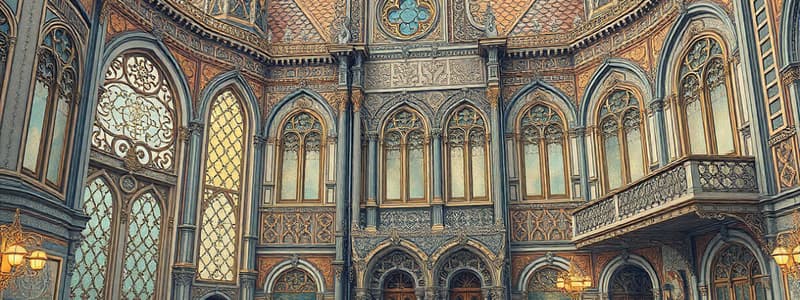Podcast
Questions and Answers
What philosophical inspiration underpins deconstructivism?
What philosophical inspiration underpins deconstructivism?
- Modernist architecture ethics
- Louis Sullivan's principles of function
- Minimalism's focus on simplicity
- Russian Constructivism and Jacques Derrida's deconstruction philosophy (correct)
Which architect articulated the motto 'Form follows fantasy'?
Which architect articulated the motto 'Form follows fantasy'?
- Peter Eisenman
- Frank Gehry
- Daniel Libeskind
- Bernard Tschumi (correct)
What is a core concept of deconstructivism in terms of architecture?
What is a core concept of deconstructivism in terms of architecture?
- Fragmentation and surface manipulation (correct)
- Avoidance of visual complexity
- Strict adherence to rectilinear shapes
- Harmonization of architectural elements
What characterizes the visual complexity of buildings designed in the deconstructivist style?
What characterizes the visual complexity of buildings designed in the deconstructivist style?
What major event in 1988 significantly advanced deconstructivist architecture?
What major event in 1988 significantly advanced deconstructivist architecture?
Which of the following elements is NOT characteristic of deconstructivist architecture?
Which of the following elements is NOT characteristic of deconstructivist architecture?
Which architect is associated with deconstructivism alongside Frank Gehry and Zaha Hadid?
Which architect is associated with deconstructivism alongside Frank Gehry and Zaha Hadid?
What aspect of architectural design is NOT emphasized in deconstructivism?
What aspect of architectural design is NOT emphasized in deconstructivism?
What architectural style is employed in the Royal Ontario Museum expansion?
What architectural style is employed in the Royal Ontario Museum expansion?
What design element connects the two themes of the museum?
What design element connects the two themes of the museum?
What was a new feature added to the museum with the expansion?
What was a new feature added to the museum with the expansion?
How does the ground level of the expansion contribute to the museum's layout?
How does the ground level of the expansion contribute to the museum's layout?
What aspect of the Royal Ontario Museum expansion enhances its visibility?
What aspect of the Royal Ontario Museum expansion enhances its visibility?
Which year was the Royal Ontario Museum expansion completed?
Which year was the Royal Ontario Museum expansion completed?
What are the two main themes showcased in the museum's atrium?
What are the two main themes showcased in the museum's atrium?
What is the purpose of the atrium in the museum expansion?
What is the purpose of the atrium in the museum expansion?
What unique architectural feature characterizes the Royal Ontario Museum's expansion?
What unique architectural feature characterizes the Royal Ontario Museum's expansion?
What role does transparency play in the design of the museum expansion?
What role does transparency play in the design of the museum expansion?
What is the primary architect associated with the expansion of the Royal Ontario Museum?
What is the primary architect associated with the expansion of the Royal Ontario Museum?
What architectural characteristic does the Crystal impart to the Royal Ontario Museum?
What architectural characteristic does the Crystal impart to the Royal Ontario Museum?
Why did the design of the Dancing House in Prague draw controversy?
Why did the design of the Dancing House in Prague draw controversy?
What nickname is given to the Dancing House in Prague?
What nickname is given to the Dancing House in Prague?
Which architectural styles are predominantly seen in Prague that contrast with the Dancing House?
Which architectural styles are predominantly seen in Prague that contrast with the Dancing House?
What year did the Royal Ontario Museum expansion occur?
What year did the Royal Ontario Museum expansion occur?
Which architect collaborated with Vlado Milunić on the Dancing House?
Which architect collaborated with Vlado Milunić on the Dancing House?
Which characteristic did the Crystal NOT bring to the Royal Ontario Museum?
Which characteristic did the Crystal NOT bring to the Royal Ontario Museum?
What was a major criticism of the Dancing House's design upon its completion?
What was a major criticism of the Dancing House's design upon its completion?
What effect did the Crystal have on the perception of the Royal Ontario Museum?
What effect did the Crystal have on the perception of the Royal Ontario Museum?
What is a significant feature of the CCTV Building's design in relation to its structure?
What is a significant feature of the CCTV Building's design in relation to its structure?
How does the CCTV Headquarters differ from typical skyscraper designs?
How does the CCTV Headquarters differ from typical skyscraper designs?
What did Rem Koolhaas suggest regarding the conception and construction of the CCTV Building?
What did Rem Koolhaas suggest regarding the conception and construction of the CCTV Building?
What architectural challenge is associated with the construction of the CCTV Headquarters?
What architectural challenge is associated with the construction of the CCTV Headquarters?
What effect does the CCTV Building create from different viewing angles?
What effect does the CCTV Building create from different viewing angles?
What was the primary inspiration behind the design of the Dancing House in Prague?
What was the primary inspiration behind the design of the Dancing House in Prague?
Who collaborated with Frank Gehry on the Dancing House project?
Who collaborated with Frank Gehry on the Dancing House project?
What materials were predominantly used in the construction of the Guggenheim Museum in Bilbao?
What materials were predominantly used in the construction of the Guggenheim Museum in Bilbao?
What significant architectural feature is characteristic of the Guggenheim Museum?
What significant architectural feature is characteristic of the Guggenheim Museum?
What concept describes the two parts of the Dancing House as presented by its creators?
What concept describes the two parts of the Dancing House as presented by its creators?
How did Václav Havel contribute to the Dancing House project?
How did Václav Havel contribute to the Dancing House project?
How many pieces of titanium were used in the construction of the Guggenheim Museum?
How many pieces of titanium were used in the construction of the Guggenheim Museum?
What does the design of the Guggenheim Museum evoke in relation to Bilbao's history?
What does the design of the Guggenheim Museum evoke in relation to Bilbao's history?
What year did the construction of the Dancing House begin?
What year did the construction of the Dancing House begin?
What architectural ideas did Gehry and Milunić explore together?
What architectural ideas did Gehry and Milunić explore together?
Flashcards are hidden until you start studying
Study Notes
Deconstructivism in Architecture
- Deconstructivism is an architectural style that emerged from postmodernism in the late 1980s.
- The key concept of Deconstructivism is to deconstruct traditional architectural elements.
- Deconstructivist architects challenge conventional aesthetics through surprising and confrontational designs.
- The movement’s principles were heavily inspired by Russian Constructivists and philosopher Jacques Derrida.
- The style is characterized by fragmentation, surface manipulation, and the use of non-rectilinear shapes, creating distortion and dislocation.
- Deconstructivism can be seen as an evolution of form following function. Bernard Tschumi’s motto "Form follows fantasy" is a testament to this evolution.
- The architectural style's emphasis on fragmentation and surface manipulation has led to unpredictable and visually chaotic designs.
- Deconstructivism can be seen as an artistic style influenced by various 20th-century movements such as modernism, postmodernism, expressionism, cubism, minimalism, and contemporary art.
- The name "deconstructivism" traces back to Jacques Derrida's "deconstruction" philosophy, which involved analyzing and dismantling the meaning of complex texts.
Key Architects and Milestones
- Deconstructivist principles were embraced and implemented in the works of several prominent architects, including Peter Eisenman, Bernard Tschumi, Daniel Libeskind, and Zaha Hadid.
- The 1988 MoMA exhibition titled "Deconstructivist Architecture" became a defining moment for this style.
- The exhibition featured work by seven influential architects, including Frank Gehry, Rem Koolhaas, and Coop Himmelblau.
- This exhibition challenged the traditional orthodoxy of modernism.
Deconstructivist Buildings
- The Royal Ontario Museum expansion in Toronto, designed by Daniel Libeskind, is a prime example of deconstructivist architecture.
- The building's organically interlocking prismatic forms and dramatic angles evoke a sense of instability and dynamic energy.
- The Dancing House, also known as the “Ginger & Fred" building, was designed by Frank Gehry in Prague. The building stands out in a city known for its baroque, gothic, and art-nouveau buildings.
- The Guggenheim Museum Bilbao, also designed by Frank Gehry, is an iconic example of deconstructivist architecture. The building is characterized by its flowing, curving forms and unconventional materials.
- The CCTV Building in Beijing, designed by OMA architectural firm (Rem Koolhaas & Partners), is known for its unconventional, loop-shaped structure.
- The Heydar Aliyev Cultural Centre in Baku, Azerbaijan, designed by Zaha Hadid, is another example of deconstructivist architecture. The building's fluid and dynamic design creates a sense of movement and energy.
Deconstructivism's lasting impact
- Deconstructivism has revolutionized architectural thinking, pushing boundaries, and inspiring new ideas.
- Its influence is reflected in the works of many contemporary architects, and continues to shape the future of architecture.
Studying That Suits You
Use AI to generate personalized quizzes and flashcards to suit your learning preferences.




